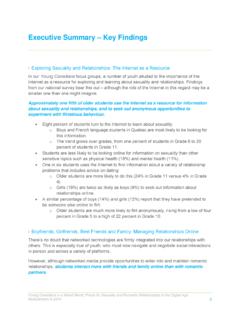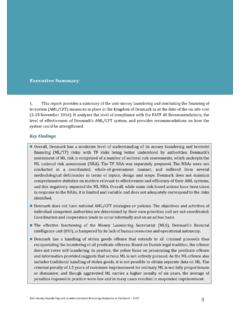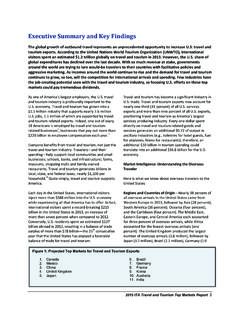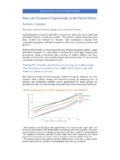Transcription of Executive Summary – Key Findings - MediaSmarts
1 Young Canadians in a Wired World, Phase III: Online Privacy, Online Publicity 2 MediaSmarts 2014 Executive Summary Key Findings Young Canadians immersion in social networking activities, as highlighted in Life Online, provides the context for understanding young people s attitudes and behaviours relating to privacy. While students are willing to post information about themselves and their personal lives online, they have very clear ideas of who should and should not be able to see what they post. They ve also developed a number of strategies to help them manage their online reputations, but their limited understanding of data privacy issues and tools shows the need for more effective privacy education.
2 It s a Social World Older teens are particularly active users of social media and frequently post information about themselves online. Ninety-five percent of Grade 11 students have Facebook accounts and nearly half of girls in grades 7-11 have Instagram and Twitter accounts. Grade 11 students (at least once a day or once a week): o Post comments or pictures on their own social networking sites (50%) o Read or post on other people s sites (73%) o Tweet (44%) o Follow friends and family on Twitter (39%) However, sharing personal information starts early. A significant percentage of younger students have social media accounts; and many of the virtual playgrounds that are popular with younger students also include social media, blurring the lines between online play and sharing information.
3 Thirty-two percent of students in grades 4-6 have a Facebook account and 16 percent have a Twitter account. Eighteen percent of students in Grade 4, 28 percent of students in Grade 5, and 37 percent of students in Grade 6 report posting information on their own social media sites at least once a week. Even with the high interest in social media, the majority of students don t post contact information online such as their home address or email address. This ranges from 90 percent in Grade 4, to 67 percent in Grade 8, to 50 percent in Grade 11. Young Canadians in a Wired World, Phase III: Online Privacy, Online Publicity 3 MediaSmarts 2014 Household rules may play a role: more than half of students report having a rule at home about posting contact information online, and students with house rules are less likely to do whatever the rule suggests they avoid2.
4 Identity Play as a Privacy Strategy Previous Young Canadians in a Wired World research has highlighted how online identity play is used by youth for a number of different reasons. This latest phase is no exception, with significant numbers of students pretending to be someone else to play jokes on friends (35%) and flirt (13%). A large percentage of students also pretend to be someone else to protect their privacy, surf anonymously and bypass age restrictions on websites. Almost half (47%) of students have said that they were someone else online to protect their privacy. Close to one third (31%) of students pretend to be someone else to post comments on news or social media sites.
5 Forty-eight percent have pretended to be older to register for a site they are too young to join. o The percentage of students who misrepresent their age rises from one fifth of students in Grade 4 to 65 percent of students in Grade 11. Control over Personal Content, Especially Photographs We know that young people s online experiences are social. But socializing is not necessarily the same thing as sharing. Students are very proactive about curating their online persona and controlling content that they don t want certain audiences to see and a number of social norms have emerged around expectations regarding what friends share, and don t share about their friends online.
6 When it comes to photos, students apply a number of social and technical strategies to keep images that they want kept private out of the public eye, including using privacy settings to block certain people, deleting content themselves or asking others to take material down. While it s not surprising that 89 percent of students say it s wrong for a friend to post a bad/embarrassing picture of them, it is surprising that more than half (54%) agree that it s wrong for a friend to post a good picture without asking first. For French speaking students in Quebec, nearly three quarters of students think this is wrong (72%). For content that they have posted themselves: o Older students are more likely to delete content about themselves (77% have done so in Grade 11, compared to 77% who have never done this in Grade 4).
7 O Their main concern is that parents (44%), family (42%) or friends (37%) will see it. 2 Steeves, V. (2014). Young Canadians in a Wired World, Phase III: Life Online. Ottawa: MediaSmarts . Available at: Young Canadians in a Wired World, Phase III: Online Privacy, Online Publicity 4 MediaSmarts 2014 o Girls are more likely to delete things, suggesting they are more concerned than boys about their online image. For photos that have been posted by others: o Ninety-seven percent of students would take steps to remove a photo they don t want others to see. The two most common strategies for doing this are to ask the person who posted it to take it down (80%) and to untag the photo (49%).
8 French language students in Quebec are more likely than English language students in the rest of Canada to go to parents (53% compared to 35%) or teachers or principals (27% compared to 14%) for help. Overall, younger students are more likely to turn to adults if they need help. Turning to parents is the primary response for students in grades 4 8. As students get older, they are generally more accepting of friends posting photos of them without asking permission (by Grade 11 just over one quarter of students expect their friends to ask them first). Audiences Matter The attention paid by students to who can see photos and comments about them online underlines the importance of audiences to young people.
9 Generally, audiences fall into three groups, with varying levels of exposure granted to each one. These include: people in each student s social circle; institutional actors; and strangers and marketers. People in Students Social Circles When asked who should be able to see their photos and content online, the majority of students included people in their social circle: friends (86%), family (68%), and boyfriends/girlfriends (59%). However, even though they are comfortable being seen by their social circle, many students especially older students actively monitor what information friends and family have access to online. For example, students are more likely to use privacy settings to block friends (31%) and family members (21%) than any group other than strangers (50%).
10 A majority of students (59%) say they would share the password to their social networking account, email account or cell phone, primarily within their social circle. o Not surprisingly, younger students are more likely than older students to say they would share their password with their parents, from a high of 66 percent in Grade 5 to a low of 14 percent in Grade 11. o While boys and girls were equally likely to share their passwords with a girlfriend or boyfriend, girls were much more likely to share passwords with a best friend. o Boys were more likely than girls to report never sharing their password with anyone at all. Even though many students are comfortable giving parents access to their online lives, a large number, especially of older students, think that parents should not constantly keep Young Canadians in a Wired World, Phase III: Online Privacy, Online Publicity 5 MediaSmarts 2014 track of them online, force them to friend them, ask for their passwords or listen in on their conversations.

















